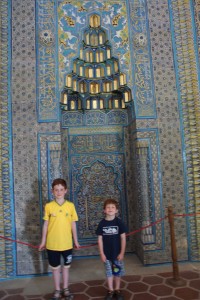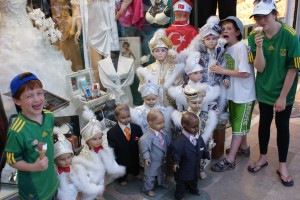Turkey Part 1:
After South Africa, our next big destination was Turkey.
This would be my fifth trip to Turkey, but the first four trips were all before the kids were born so it had been a long time. My wife Hilit and I and our three kids, Eitan (5), Daniel (9) and Gal (13) would be backpacking and traveling through the country by bus. We would also be going well off the standard tourist route. Yes, we would be visiting Istanbul, but we would also be going to the old Ottoman capital of Bursa and then making our way through the little known Black Sea region to the Georgian border.
The only part of the Black Sea region that I had been to before was Trabzon. Nearly twenty years ago, my wife to be and I had backpacked through the Far East of Turkey, visiting places that are still only partly visited these days – Kars & Ani, Dogubeyazit, Van, Mt Nemrud. I had also traveled extensively in Istanbul, the Turkish Meditteranean and Cappadocia. Over the past 20 years the tourist industry in Turkey had matured a great deal, and what had been a dirt cheap backpacker’s heaven had morphed into a major tourist destination. I figured that the Black Sea region was the least known region, and I hoped that we would still find the “real”, “authentic” Turkey over there – unsullied and unspoilt by the influx of millions of tourists each year. We would be backpacking again, and also carried two self inflating camping mattresses and a sleeping bag with us.
We were rewarded in spades!
We landed in Istanbul in the early morning. After clearing customs and immigration, I bought a local Turkish SIM card at the Vodaphone booth – cost was 40 TL but this included only 5TL of talk time. Expensive – in South Africa we had a bought a local SIM card for 50 cents! Our destination for the day was Bursa, across the Sea of Marmara. My guidebooks said that the best way to get there was to go into downtown Istanbul and catch a ferry from there as the bus journey would take much longer. The Istanbul metro stop reaches the airport and we bought our jetons (free for Eitan, but the rest of us needed one) and went on the metro. New and fast, I saw that a nearby stop was Otogar (Bus Station) and I made a split decision to get off there and take the bus. The Istanbul bus station is a vast improvement on what it had once been. It is huge, and offices representing hundreds of bus companies from across the country sit next to each other in a huge square plaza. We went to Ulusoy (one of the best known companies), learned that there would be a bus to Bursa in half an hour, bought our tickets and waited. I took the boys to get some food – small kiosks offer traditional food such as sandwiches, doner kebabs, soup, rice and kofte (meatballs). The boys were happy with their food – a good start.
I had hope that the bus would take about 4 -5 hours but the trip dragged on and on. It became clear to us that we had made a mistake but it was too late to turn around. The bus made its way through Istanbul’s outskirts, and then we inched our way through what seemed to be rush hour traffic to a ferry terminal (not the one we would have taken had we chosen to avoid the bus) where we had to wait for a ferry that eventually took us across the sea. To make matters worse, the air conditioning wasn’t working properly.
We eventually arrived at the Bursa Otogar about 7 hours after departure, and at our hotel about 30 mins later. It was hot, really hot – and we were very thankful to put all our stuff down. We were staying at the Hotel Artic, a smallish three star hotel right in the centre of the city.
Why Bursa? Ottoman Turkey had three capitals – Edirne, Bursa and finally Istanbul. Bursa was known to have beautiful early Ottoman buildings and mosques, and is regarded as a Turkish city that has still kept its charm even after much growth over the past decades, It is close to mountains and forests and even a ski resort. It also is famous for its hot springs and the outskirts are dotted with hotels and spas. We didn’t have enough time to do it complete justice – we would be exploring the city center – the mosques, bazaars and markets.
The city was buzzing. We visited the famous Green Mosque and the central tea garden. We wandered the old streets and examined all the food for sale. Very quickly the kids were eating dondurma in the Maras style – a sticky ice cream that can be pulled, squished, held upside down… lots of fun and tasty as well. We were “befriended” by a souvenir store owner who actually had wonderful ceramic plates – we decided not to get anything as we still had a month of cross country travel ahead of us – we never saw plates as beautiful or as cheap again!
The kids had never been in a mosque before – they were surprised to see how much room there was inside – no chairs, no pews, just carpets everywhere – an ideal space to run around. And beautifully decorated ceilings and walls with incredible patterns and motifs. Very quickly the kids learned that visiting mosques was fun!
Outside the Green Mosque the kids discovered the equivalent of a Turkish yoyo – colorfully decorated wooden spinning tops (seemingly hand made) that sold for about a lira each (75 cents). A great deal for lots of fun. We also saw many stores selling kids clothes – really dressy clothes, which we thought were for Ramazan a few weeks later. The kids loved the mannequins!
Bursa is famous across Turkey as the home of the Iskender or Bursa kebap. Kebab (often spelled Kebap) is often an allround word for most meat dishes in Turkey – it can be on a revolving spit (called Doner), it can be sliced, it can be on skewer, it could be chopped in stew – it can basically mean lots of things.
Our plate looked like this : first, a layer of chopped bread, then slices of beef on to, covered with a special tomato sauce, with yoghurt on the side and melted butter poured on top. It is rich, very rich, and Bursa has some restaurants that have been serving this for over a hundred years. We were directed to one (apparently) the most famous of them all, the original Iskender restaurant on Unlu Caddesi. It was expensive and the kids refused to eat it – it was just way too rich and they were put off by the whole mix. I enjoyed it but bottom line – not a great success. It was one of our more expensive meals in Turkey and I was really the only one who ate.
We went to the tea gardens and watched the people watching the fountains. – I also had my first experience (this time round) of Turkish public toilets. Most toilets in Turkey are squat toilets – and often have no toilet paper though there is always plenty of water available (Turkish people use water to clean up) – and private – we are talking about cubicles here. It takes a bit of getting used to and maneuvering, but ultimately squat toilets seem much cleaner than western style sit down toilets – first, you don’t come into contact with anything, and second, its quick. No reason to sit around, literally. Just always have toilet paper on hand, unless you plan to use water as well. The result is that the public toilets are clean, often with an attendant on hand who is sloshing water all over the place, mopping up and cleaning, though you usually need to pay a small fee (about half a lira). Soon the whole family was managing the toilet issue very easily. And there are always toilets around – every mosque in Turkey has toilets attached – clean and available.
After more wandering around , it was back to the hotel for some relaxing in front of the TV.
PS: These days I am planning great family trips to Turkey. If you’d like to see how I can help you, click here.


